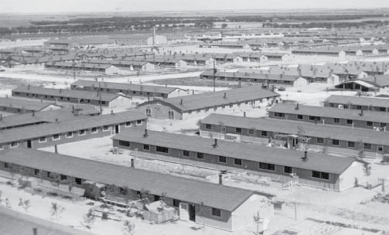Activity
“Relocation”–Understanding Location and Place
Objective: Students will 1) learn the difference between location and place; 2) identify the location and place characteristics of different cities; and 3) reflect on the effects of a sudden change in location and place on Japanese Americans when they were forced to evacuate and relocate during World War II.

Granada Relocation Center: Amache
After Japan bombed Pearl Harbor on Dec, 7, 1941, President Roosevelt issued Executive Order 9066. Signed on Feb. 19, 1942, the order gave the military broad powers to ban and evacuate any citizen on the West Coast, including California. While Executive Order 9066 applied to “any or all persons,” the newly established War Relocation Authority (WRA) began deporting Japanese immigrants (Issei) and incarcerating approximately 120,000 Americans of Japanese descent (Nisei). The WRA imprisoned them in ten “internment camps” built in deserts and swamplands, including in Amache, Colorado. The Executive Order uprooted entire communities, as Japanese immigrants and Japanese Americans were forced to leave their homes and jobs.
During World War II, Arthur Okamura and his family were involuntarily relocated from their home in Compton, California, detained at the Santa Anita Assembly Center, and later transferred to the Granada War Relocation Center, where they were incarcerated for three years. Okamura was 10 years old when he entered the “internment camps.”
In this lesson, students will 1) learn the difference between location and place; 2) identify the location and place characteristics of different cities; and 3) reflect on the effects of a sudden change in location and place on the Japanese Americans when they were incarcerated.
Content Standards (California)
History and Social Science (Grade 1):
HSS 1.4: Students compare and contrast everyday life in different times and places around the world and recognize that some aspects of people, places, and things change over time while others stay the same.
HSS 1.4.1: Examine the structure of schools and communities in the past.
HSS 1.2: Students compare and contrast the absolute and relative locations of places and people and describe the physical and/or human characteristics of places.
HSS 1.2.4: Describe how location, weather, and physical environment affect the way people live, including the effects on their food, clothing, shelter, transportation, and recreation.
Materials
Internet access
“Location and Place: A Geographic Perspective,” National Geographic
“How to Make an Illustrated Map in 8 Steps,” The New York Times
Vocabulary
Place: (noun) a way to understand a topic or area using spatial features and relationships.
Location: (noun) position of a particular point on the surface of the earth.
Geographic perspective: (noun) area having unique physical and human characteristics.
Incarceration: (noun) the state of being confined in prison; imprisonment.
Relocation: (noun) the action of moving to a new place.
Executive Order 9066: issued on Dec. 7, 1941, the order gave the military broad powers to ban and evacuate any citizen on the West Coast.
Procedure
- Visit the National Geographic website and complete the lesson “Location and Place: A Geographic Perspective”.
- Introduce Executive Order 9066, the relocation of Japanese Americans, and Arthur Okamura.
- Explain: Students will use Arthur Okamura’s relocation as a case study to understand the difference in location and place between Compton, California, and Amache, Colorado.
- Research: Divide students into four groups to research the following:
- Compton, California, in terms of location
(where it is, such as the city, state, or country) - Amache, Colorado, in terms of location
(where it is, such as the city, state, or country) - Compton, California, in terms of place
(what it is like, such as hot or cold, urban or rural) - Amache, Colorado, in terms of place
(what it is like, such as hot or cold, urban or rural)
- Compton, California, in terms of location
- Discuss: Have the class share their findings on the two cities.
- Reflect: Ask students to imagine that they grew up in Compton and suddenly, without warning, had to move to Amache.
What would you have access to? What would you lose access to? What kind of clothes would you need to pack? What would you be able to do in your new location? What would be more difficult to do? What kind of thoughts would you have about the sudden forced removal? - Conclusion: Draw from students’ comments to make connections with the fears and concerns of Japanese Americans when they were incarcerated in 1942.
Extension:
- Read the instructions in “How to Make an Illustrated Map in 8 Steps” on the New York Times website.
- Based on their findings, have students create illustrated maps of Compton and Amache.
For more lesson plans based on Arthur Okamura, visit this artist’s teacher packet.





